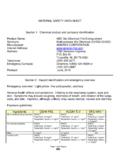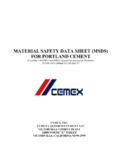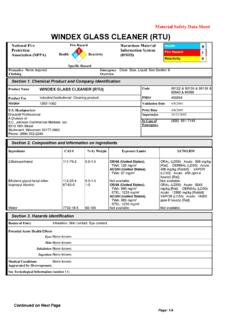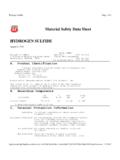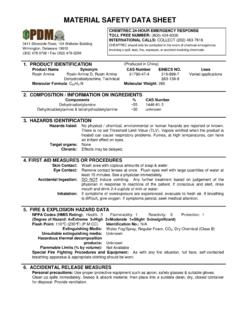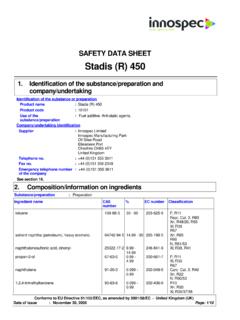Transcription of Product Name: Purple K Dry Chemical Fire …
1 MATERIAL SAFETY DATA SHEET. Section 1. Chemical Product and company identification Product Name: Purple K Dry Chemical fire extinguishant Synonym: Potassium Bicarbonate, KDC, PK. Manufacturer: AMEREX CORPORATION. Internet Address: Address: 7595 Gadsden Highway Box 81. Trussville, AL 35173-0081. Telephone: (205) 655-3271. Emergency Contacts: Chemtrec 1(800) 424-9300 or (703) 527 3887. Revised: September, 2003. Section 2. Hazard identification and emergency overview Emergency overview: Light Purple , fine solid powder, odorless. Adverse health effects and symptoms: Moderate irritant to the respiratory system and eyes; mild irritant to the skin. Symptoms may include coughing, shortness of breath, and irritation of the lungs, eyes, and skin. Ingestion, although unlikely, may cause gastric distress. Exposure guidelines: Ingredients OSHA PEL ACGIH TLV DFG MAK *.
2 PNOC** PNOC PNOC. Potassium bicarbonate Total dust, 15 mg/m3 Total dust, 10 mg/m3 Total dust, 4 mg/m3. Respirable fraction, 5 mg/m3 Respirable fraction, 3 mg/m3 Respirable fraction, mg/m3. Mica 6 mg/m3 3 mg/m3 ------- PNOC PNOC PNOC. Attapulgite clay (1-10% quartz) Total dust, 15 mg/m3 Total dust, 10 mg/m3 Total dust, 4 mg/m3. Respirable fraction, 5 mg/m3 Respirable fraction, 3 mg/m3 Respirable fraction, mg/m3. Silicone oil NR** NR NR. Violet 23 pigment NR NR NR. Page 1 of 7 Pages Purple K. *German regulatory limits **PNOC = Particulates not otherwise classified (ACGIH) also known as Particulates not otherwise regulated (OSHA) ** NR = Not Regulated. All values are 8 hour time weighted average concentrations. Hazard symbols: WHMIS (Canadian workplace hazardous materials identification system). D2B may irritate eyes, mucous membranes, or skin Section 3.
3 Composition/information on ingredients Name/Compound Weight % CAS #. Potassium bicarbonate 93 298-14-6. (potassium hydrogen carbonate)- may contain minor calcium carbonate Attapulgite clay or Fullers earth 4 12174-11-7. magnesium aluminum silicate- 1-10% crystalline silica 14808-60-7. Mica 2 12001-26-2. potassium aluminum silicate Silicone oil < 63148-57-2. methyl hydrogen polysiloxane Violet 23 pigment < 6358-30-1. oxazine dye Section 4. First Aid Measures Eye Exposure: Irrigate eyes at eye wash station and repeat until pain free. Seek medical attention if irritation develops or persists, or if visual changes occur. Skin Exposure: In case of contact, wash with plenty of soap and water. Seek medical attention if irritation develops or persists. Page 2 of 7 Pages Purple K. Inhalation: If respiratory irritation or distress occurs remove victim to fresh air.
4 Seek medical attention if irritation develops or persists. Ingestion: If victim is conscious and alert, give 2-3 glasses of water to drink. If conscious, induce vomiting. Seek immediate medical attention. Do not leave victim unattended. To prevent aspiration of swallowed Product , lay victim on side with head lower than waist. Medical conditions possibly aggravated by exposure: Inhalation of Product may aggravate existing chronic respiratory problems such as asthma, emphysema, or bronchitis. Skin contact may aggravate existing skin disease. Chronic overexposure may cause pneumoconiosis ( dusty lung disease). Section 5. fire fighting measures Extinguishing media: non combustible and non flammable Product is an extinguishing agent Unusual fire /explosion hazards: in a fire this material may decompose, releasing oxides of carbon, potassium and nitrogen (see Section 10).
5 Insensitive to mechanical impact or static discharge. HMIS Hazard Ranking: health = 1, flammability = 0, reactivity = 0, personal protective equipment: use N-95. dust mask (see Section 8). Section 6. Accidental release measures Clean up released material using vacuum or wet sweep and shovel to minimize generation of dust. Wear appropriate respiratory protection. Bag and drum for disposal. If Product is used and/or contaminated, use PPE and containment appropriate to the nature of the mixture. Prevent material from entering waterways. Section 7. Handling and storage Avoid skin, eye, or respiratory exposure. Use appropriate PPE when handling or maintaining equipment, and wash thoroughly after handling (see Section 8). Keep Page 3 of 7 Pages Purple K. Product in original container or extinguisher. Contents may be under pressure . inspect for extinguisher rust periodically to insure container integrity.
6 Do not mix with other extinguishing agents, particularly ammonium phosphate. Do not store in high humidity. Section 8. Exposure controls/ personal protection During the application of this Product against fires, exhaust gases and the products of incomplete combustion (PICs) are the principal respiratory hazards. In the manufacture of extinguishers, automated systems and point source ventilation controls sufficiently minimize respiratory exposure. Employers and employees must use their collective judgment in determining occupational settings where the use of a dust mask or air purifying respirator is prudent. The need for respiratory protection is not likely for short-term use in well ventilated areas. Respiratory protection: use N95 dust mask for limited exposure, use air-purifying respirator (APR) with high efficiency particulate air (HEPA) filters for prolonged exposure.
7 Eye protection: wear Chemical goggles or full-face APR. Skin protection: use nitrile, latex, or similar gloves and coveralls. Good personal hygiene practices essential, such as avoiding food, tobacco products, or other hand-to- mouth contact when handling. Wash thoroughly after handling. Section 9. Physical and Chemical properties Appearance: light Purple powder, finely divided odorless solid. Specific gravity: ~ Solubility: Product is coated, not immediately soluble in water Non flammable Flash point: none Vapor pressure: < 1 mm Hg pH: approximately 9 10 for a 10% solution Boiling point: not applicable No explosive or oxidizing properties Page 4 of 7 Pages Purple K. Section 10. Stability and reactivity Stability: stable Incompatibles: strong acids, ammonium phosphate, lithium. Decomposition products: heat of fire may release carbon monoxide, carbon dioxide, and oxides of potassium and nitrogen.
8 Possibility of hazardous reactions: none Section 11. Toxicological information Acute toxicity: Potassium bicarbonate LD50 (rat): unknown, testing has not been conducted. Relatively non-toxic. Target organs in man: respiratory system. This Product is a mild irritant to epithelial tissue, (eyes, mucous membranes, skin) and may aggravate dermatitis. No information was found indicating the Product causes sensitization. Chronic toxicity: Pneumoconiosis, or dusty lung disease, may result from chronic exposure to any dust. Reproductive toxicity: This Product 's ingredients are not known to have reproductive or teratogenic effects. Section 12. Ecological information Ecotoxicity: negative effects unknown. Provides nutrient phosphorus to plant life. Persistence/. Degradability: degrades rapidly in humid/wet environment Bioaccummulation: extent unknown Mobility in soil: water soluble, may leach to groundwater Page 5 of 7 Pages Purple K.
9 Section 13. Disposal considerations This Product is not a RCRA characteristically hazardous or listed hazardous waste. Dispose of according to state or local laws, which may be more restrictive than federal laws or regulations. Used Product may be altered or contaminated, creating different disposal considerations. Section 14. Transportation information This Product is not defined as a hazardous material under Department of Transportation (DOT) 49 CFR 172, or by Transport Canada Transportation of Dangerous Goods regulations. Section 15. Regulatory information International Inventory Status: All ingredients are on the following inventories Country(ies) Agency Status United States of America TSCA Yes Canada DSL Yes Europe EINECS/ELINCS Yes Australia AICS Yes Japan MITI Yes South Korea KECL Yes European Risk and Safety phrases: EU Classification: Irritant R Phrases: 20 Harmful by inhalation.
10 36/37 Irritating to eyes, respiratory system. S Phrases: 22 Do not breathe dust. 24/25 Avoid contact with skin and eyes 26 In case of contact with eyes, rinse immediately with plenty of water and seek medical advice. 36 Wear suitable protective clothing. Page 6 of 7 Pages Purple K. federal regulatory information: None of the chemicals in this Product are under SARA reporting requirements or have SARA threshold planning quantities (TPQs) or CERCLA reportable quantities (RQs), or are regulated under TSCA 8(d). State regulatory information: Chemicals in this Product are covered under specific State regulations, as denoted below: Alaska - Designated Toxic and Hazardous Substances: None California Permissible Exposure Limits for Chemical Contaminants: None Florida Substance List: Mica Dust Illinois Toxic Substance List: None Kansas Section 302/303 List: None Massachusetts Substance List: Mica Dust Minnesota List of Hazardous Substances: None Missouri Employer Information/Toxic Substance List: None New Jersey Right to Know Hazardous Substance List: None North Dakota List of Hazardous Chemicals, Reportable Quantities: None Pennsylvania Hazardous Substance List: None Rhode Island Hazardous Substance List: Mica Dust Texas Hazardous Substance List: No West Virginia Hazardous Substance List: None Wisconsin Toxic and Hazardous Substances.
